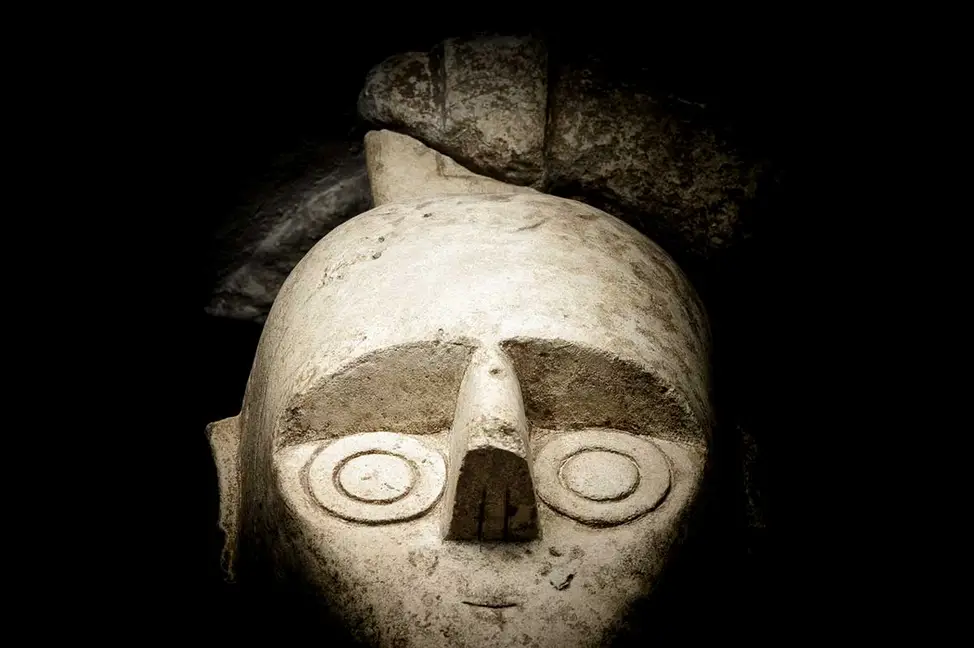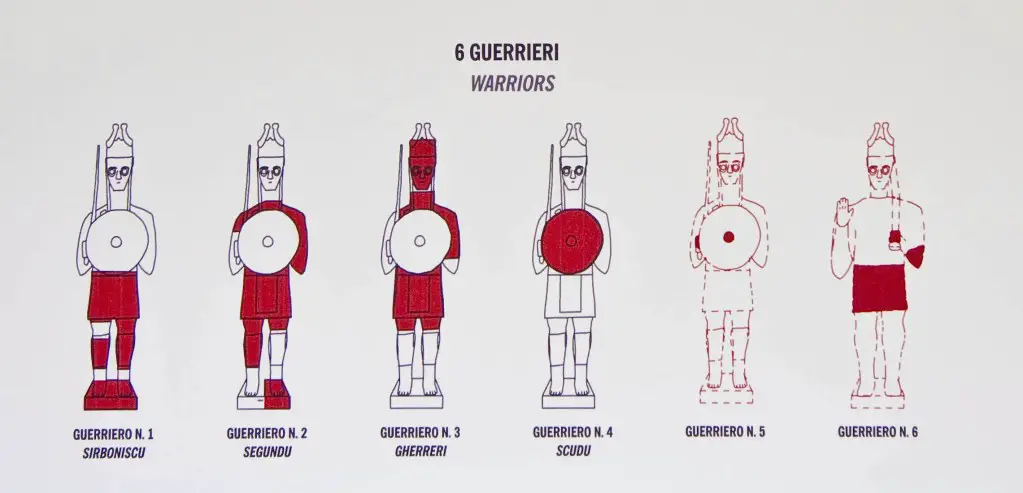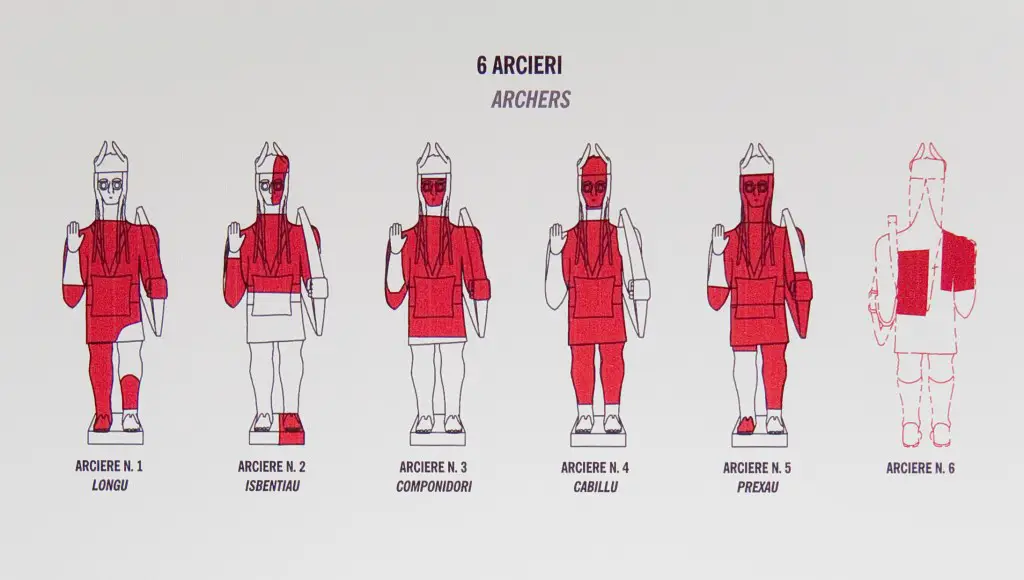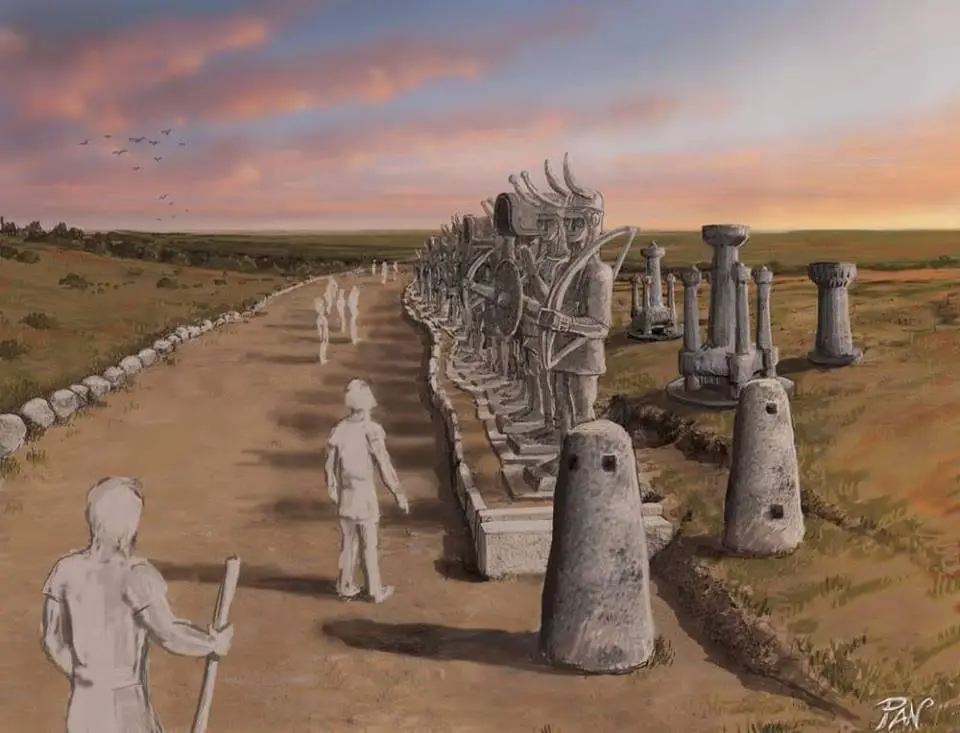Archaeological analysis of the famous Sardinian site of Mont'e Prama, in the Sinis peninsula, through a retrospective of the excavations carried out and the findings.
di Ascanio Modena Altieri
The geographical context - the protagonist of most of the findings - is to be placed in the area of Mont'e Prama, located at 50 m asl in a strategic point of the Sinis peninsula, in which already in the mid-sixties - 1965-1966 survey at the sacred well of Banatou Narbolia - numerous Punic and Nuragic finds had been found, with the addition of a badly preserved one large head identified in the Mont'e Prama type. As regards specifically the discovery of the many statuary fragments, we must refer to the fortuitous discoveries made in March 1974 by Sisinnio Poddi and Battista Meli, in land used for cultivation owned by the Confraternity of the Holy Rosary of Cabras. Dr. Giuseppe Pau was the first to alert the Superintendence of Archaeological Heritage of Cagliari and Oristano.
Shortly thereafter, many of the artifacts already accumulated and improperly considered not of value, were in all probability looted, unfortunately before Dr. Joseph Atzori could publicly denounce the very serious lack of even the slightest care and protection of what, according to the academic opinion, will represent an archaeological unicum. Immediately there was the intention to open an essay - albeit small - and the mobilizations for a series of excavations of short duration - Atzori excavations in 1974, Pau excavations in 1977. At the same time, better structured excavation campaigns were planned, to restart in the missions of Bedini in 1975, of Lilliu, Tore, Atzeni in January 1977 and in Tronchetti-Ferrarese Ceruti excavations, which began in 1977 and lasted until 1979. Only in 2014 and between 2015-2016, first Dr. Pumpkin and then Dr. Usai research will resume, supported by new technologies in the geophysical field.

The main problems regarding the vast site of Mont'e Prama are due to the dating, the stylistic characteristics, as well as the very end of the necropolar-sanctuary site. The temporal coordinates and the consequent fan would like the following statuary a few centuries to the burials - specifically the buried ones - which, according to the latest radiocarbon tests, would go back to years between 1380 and 1080 BCE Established that it is a similar complex for ritual and religious issues, but not entirely identical, to the so-called "Tombs of the giants" of the Bronze Age, we can however note a certain ideal continuity between one period and another.
According to the most recent research, the statues therefore date back to the very early Iron - XNUMXth and XNUMXth centuries - which would explain the high quality of the statues, despite their evident stylization. This has been defined by Lilliu - particularly with regard to eyes and faces - as a manifest desire to frame these figures in a non-human universe, therefore in another world, probably mystical and metaphysical, which would make the faces of the giants of Mont'e Prama vehicles, high identifiers, rather than plausible representations. As far as styles are concerned, we will investigate the theories considered to be the most valid today, even though they may at times seem obsolete.
The prof Tronchetti and Bedini they speak to us of an orientalizing taste, both for the client and for the execution, glimpsing in these statues of analogies with archaic Etruscan sculpture. According to Peter Rockwell, the statues are a unicum for style, technical refinement and unprecedented formulation. Rendeli also points out that the never seen well tombs are to be attached to this sculptural novelty. We are therefore dealing with artisans influenced by many crucial locations in the Mediterranean - Levant and Egypt - in a nuragic-Tyrrhenian framework of the highest commission. Giovanni Lilliu instead, it refers to a pure geometric style, certainly partly coeval with the construction of the statues, but not totally detectable. It is also true that the engraved details and certain formal choices remind us of properly geometric Aegean ceramics. Other theories would like the statues to be framed in an area of stylized Italic taste and influenced by Aegean naturalism.

For the construction of the giants - most of which have mounting attachments - the main material is a fairly soft limestone, certainly of neighboring origin, in which very small traces of malacofauna and other marine fossils have even been identified. After the restoration phases started in 2007 and ended in 2012, it was possible to collect a large amount of data on the various techniques and methodologies used. Having no older or later counterparts to those we have received - without considering stylistic details - we can only note a very high technical capacity of the artisans who have dealt with these sculptures. Nonetheless the taste and reference to primitive and archaic stylistic features, would suggest that these stone giants were based on earlier models - bronzes - with the evident addition of qualitatively exceptional details and finishes, to be attested in historical epochs certainly identifiable in the first two centuries of the first millennium aev Regarding the techniques and methods, Dr. Peter Rockwell, an internationally renowned sculptor, provided interesting insights for the analyzes then developed by Minoja and Usai. But let's move on to some summary points regarding comparisons and methods:
"Unlike the Greek kuroi, which were sculpted in a prone position and were equipped with a support, the Sardinian giant was directly sculpted vertically, placed on a quadrangular base and does not have any type of support except in the ankles, which makes it , at least ideally, a monument to be observed at 360 ° rather than just from the front as can be true for the Greek anthropomorphic signs. The Sardinian workers have overcome the fear of spatiality, held in high regard by the Greeks, equipping the giants - especially boxers and archers - with parts of the body or suspended objects, projecting, therefore at potential risk of splitting. "

One of the most fascinating details is represented by the eyes, obtained with two perfectly concentric circles. The achievement is still debated: the compass is excluded, known at the time but not used because there is no holes inside the eyes, therefore the achievement of a similar geometric perfection still represents an enigma today. Less smoky is the obtaining of parallel lines and decorations a chevron very difficult to engrave in the absence of two fundamental factors: a deep knowledge of sculptural techniques and the use of a graduated ruler.
We also have the possibility of identifying the use of instruments completely new to other cultures of the same era. In general, the tools used can be summarized as follows: chisel, six-tooth step, scraper - debated -, subbia, naturally abrasive material for the final details - pumice -, drill - unknown to the Greeks but abundantly used by the Egyptians - and round iron. For the models of nuraghe, on the other hand, the use of bow drills, having been found particularly deep holes. Regarding the processing phases of the works, we can summarize them in four main phases: working with cork in vertical position; passage of the step; phase of abrasives and scrapers. In the final measure, sharp-edged chisels and probably also dry points would have been used for the most meticulous finishes.

The excavations of 1975 by dr. Bedini have unearthed one large necropolar area - 25 × 3 long essay - with the discovery of ten well burials - with dead curled up -, however without the protective slab. Between 1977 and 1979, the Tronchetti-Ferrarese Ceruti excavations immediately brought to light one monumental road, linked to the necropolis and to what was being revealed as a complex statuary system. According to studies, the large sculptures and the road would have been built in contemporary times and the discovery of a fragment of a Punic amphora - stratigraphically under a fragment of a statue - would date the destruction of the site to the 2014th century BC.However, the dating of the statues still remains debated, despite the suggested hypotheses. In 6 the Zucca campaign, by means of a georadar prospecting, managed to identify a little more than XNUMX and a half hectares as a man-made area, while another eight graves were found south of the already probed Tronchetti sector.
I findings of large inventories statute - two new boxers, models of polylobed nuraghe and a supposed fragment of a statue - betilo -, have led to think that the area may have been the site of a santuario. In the latest excavations conducted by Usai it was decided to trace the previous excavation works as well, also investigating the Nuragic buildings A and B, adjacent to the necropolis. In addition to new findings of statues and models of nuraghe, there were also fragments of bronzes and ceramic fragments dating from the Middle Bronze to the Early Iron Age. The analyzes concerning the lithic finds can be divided purely by typological categories. As for the skeletons analyzed - about forty out of about 62 identified graves - we can deduce that we are dealing with a series of young men, from about twenty up to 42 years of age, evidently selected to be buried in what, to such an extent, appears to be a real heroon.

The analyzes carried out lead us to think that it was a select line-up of highly esteemed and well-liked warrior-athletes from their community, whose diets consisted of both earthly and marine meat. The joints of the bones of the legs and arms - especially the right - lead us to the conclusion that these individuals were undoubtedly devoted to great physical effort, but at the same time it is logical to think of an aristocratic social status. Not being able to specifically focus on bronzes, numismatics, ceramic finds and sepulchral complexes in themselves, we will carry out both a substantial and symbolic analysis of the funerary signs, that is the statues themselves, which have some common characteristics such as the pattern of the T-shaped face, known also for the bronzes and the stele statues from nearby Corsica.
Each giant has a height between 2 and 2,50 meters and thanks to some studies also reported by Tronchetti and Lilliu, we know that the statues were certainly - not a novelty for the ancient world - brightly polychrome; black and red are colors identified with certainty. These statues are presented in a basic form almost identical to each other - slightly bent legs and straight torso - in fact the only elements to differ are the more specific ones, between objects, clothing and positions of the arms. But let's move on to the actual categories, omitting the betyl section in order not to exaggerate.
Warriors: five warriors are certainly identified - plus a sixth possible thanks to a shield boss that has come down to us -. The warrior has a sword that rests on the right shoulder, a breastplate formed by vertical plates, short on the back, wide on the chest and particularly robust on the shoulders. On his head there is a sachet helmet with horns, ending with small spheres. A round shield - modeled on the pintadere - finely decorated with geometric motifs, concludes the equipment.

Archers: Also for the archers there are five specimens plus a sixth of which few fragments remain. The classic type comes with a short tunic, a square plate - presumably metallic - on the abdomen, leggings, sandals, canopy, crested and horned helmets - but without the spheres of the warriors - quivers and bows. The latter differ in two types, one heavier and quadrangular in shape, the other lighter with a cylindrical section. It is therefore possible to hypothesize for these latter cases, a mixed weaponry between sword and bow. Four large relief braids descend on the chest to frame a well marked goliera.

Boxers: undoubtedly the largest group among the statues. The peculiarities of the boxers are the glove, similar but not identical to the caestus, the large rectangular and rounded shield - probably covered in leather but made of wood - and the kilt with a tailcoat that highlights the bare chest, in which some signs of the body are sketched - see the navel -. Some variants would show instead of boxers-priests, equipped with a conical hat, similar to that of the Etruscan haruspices.

Nuraghes: there are three types identified, namely single tower, quadrilobate and polylobe structures. These models of structures were composite, presenting in some specimens lead cores that would suggest real joints - see the central towers of the quadrilobates -. On all the transpositions there are details that help us to understand the original state of the real structures, such as toothed railings, parapets and high terraces. However, these details are not sufficient to explain and to ensure a certain answer for the use made of these bobbins. The four-lobed are about 1,40 in height, while the single towers range from 13 to 70 cm in diameter.

Despite the slowness and the problems regarding museum creation, with particular attention to the unworthy proposal to unpack the statuary group in three different museums, at an archaeological and cultural level, the Giants of Mont'e Prama can rightly represent, as stated even from those who have already written abundantly bibliographies from which this work draws, an unprecedented context for peculiarities and details that we have not been able to perfectly match with other cases. The personal position of the writer is that it is, as already remarked fragmentarily earlier, a celebratory complex of a small aristocratic circle, both physically and politically powerful.
This, in a period of time that lasted for about five centuries, from the end of the Bronze to the beginning of the Iron, has been able to gather around him artistic workers of vast origin - Levant, Egypt, Greece - confirming the personal opinion that he would like these men as descendants or real idols of Shardana, people of the sea well known in all three areas mentioned above. To conclude, we can undoubtedly state that the giants of Mont'e Prama were inspired by the previous bronze work, in terms of shape and spatiality. Furthermore, they are a shining example of how the artistic and celebratory culture, from the fertile crescent to the western Mediterranean, has been able to blend and intertwine, in order to obtain a composite but at the same time unpackable style and, if carefully observed, recognizable in what can be well defined as a sort of large shared artistic-cultural area.
